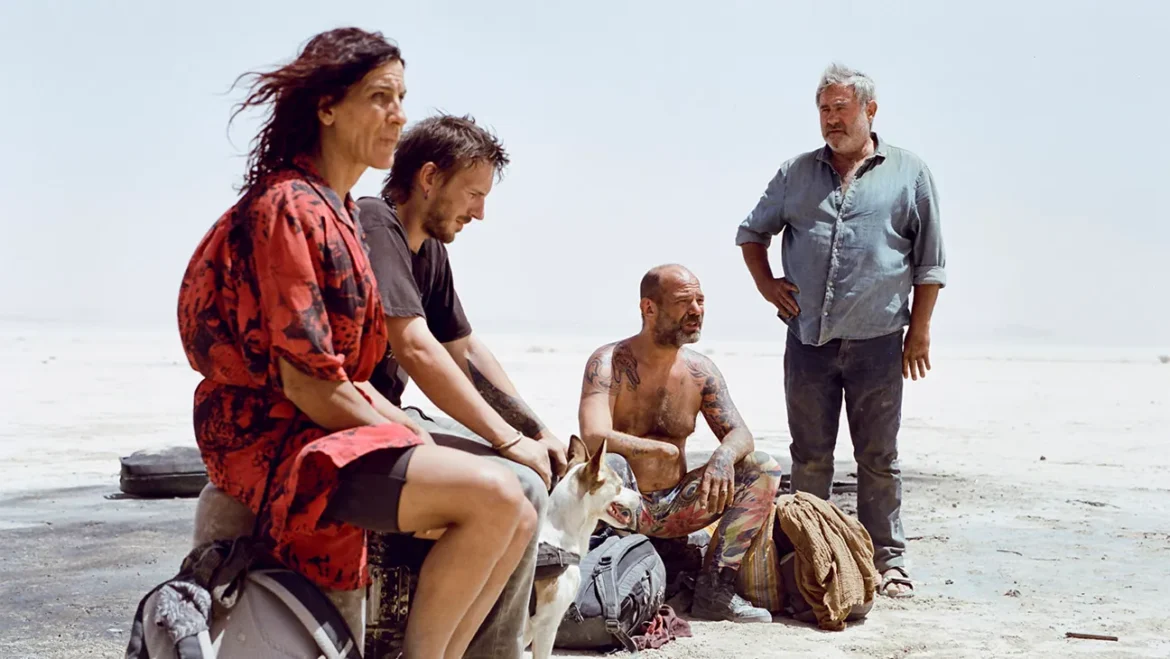A fine line between heaven and hell in Spain’s latest submission for Best International Feature at the Academy Awards.
In an interview with Mubi at Cannes in 2016, director Oliver Laxe offered an early glimpse into the currents guiding his cinematic instincts, having just debuted his second feature film, Mimosas, at the 69th edition of the festival. “One question I was putting to myself in this film, and what other filmmakers ask themselves, is how to manifest the ineffable, the mystery in images.” With his latest contribution to Cannes – the Jury Prize-winning Sirat – Laxe rededicates himself to celebrating the enigmatic and open questions inherent to the visual medium with an overlapping desert epic that breathes spiritual life into a setting condemned by its earthly sins.
Laxe has found something of a muse in the deserts of North Africa, first with Mimosas (a sweeping piece of mythical realism that found critical intrigue, if not acclaim) and now with the Neon-distributed, festival darling Sirat. The French-born Galician’s vision draws on a kind of cinematic and spiritual syncretism to consecrate something distinctly phenomenological – striking chords so dissonant and unnerving as to create a kind of emotional mirage with each passing scene. Since a screening at the 63rd annual New York Film Festival, the film has stayed with me in ways small and large, yet the emotional and interpretive sands of Sirat continue to shift under my feet.
The title of the film is a Muslim eschatological reference, an opening title card describing it as a narrow bridge between Paradise and Hell. Characters and audience alike come to find that this theological landmark is razor thin and perhaps non-linear, as an infernal and wandering kaleidoscope unfurls across the 115-minute runtime. Seizing on imagistic and material opportunities both modern and mystical, Laxe deploys rave culture as the foundation from which to base his critical and stylistic expression. Techno producer Kangding Ray’s pounding score backs the opening scene – a DIY rave that heaves across the open Moroccan desert (perhaps a contemporary hearkening to Nietzsche’s Birth of Tragedy), as a father and son weave through the disheveled, ascetic crowd to distribute flyers of their lost family member Mara. Empty-handed and bereft of leads, Luis and Esteban appeal to a caravan of transient ravers in a bid to find a subsequent desert party where Mara is alleged to have decamped.
What follows is a jarring amalgam of Mad Max, road film, desert epic, realist nightmare, and mystical tragedy – harnessing a narrative that eludes any kind of structurally classic footing. Surrounding the film’s on-screen events is an off-screen apocalypse; allusions to WWIII and the dissolution of national borders enter the atmosphere in the form of distant radio correspondence and the arrival of the Moroccan army to break up the Dionysian euphoria of the initial rave. The territory is both geographically and thematically vast, all the while offered up as a straightforward evolution of events. The effect is something profoundly physical and almost corporeal in its presentation – Laxe appears uninterested in the black box of human consciousness – and the film is better for it. The subliminal coordinates of Sirat are evidently both material and spiritual, a contrast at the heart of the film and one that drives its discordant tonal force forward through the arid hinterlands. Additionally, Ray’s score is rife with resonant fundamentals like four on the floor, but more notable is his deployment of sustain and release to create a kind of textured alienation that leaves the intrepid band somehow even more exposed in the untrammeled sands of Northern Africa. On the surface of the film’s narrative dimension, all of this redounds to something akin to a journey to nowhere. But in deeper crevices, Laxe has coaxed an entire world of experience into being.
Where Sirat succeeds in apprehending the ineffable with its palette of physical substrates, it also reveals a searing critical position within the context of the contemporary age and its attendant philosophical assumptions. Nowhere is this more apparent than in the depiction of the raver caravan, an abject cast of characters who at first cut sympathetic figures, only to morph into the object of the filmmaker’s ruthless ire. The group demonstrates an ascetic meekness redolent of Christ’s huddled masses, limbs amputated, possessions rejected, wandering a foreign desert with mystic conviction. They offer up what little food they have rationed to the desperate father and son, espousing gentle overtures of a communal philosophy that neither proselytizes nor seizes the levers of power open to them in the asymmetric arrangement. Yet we cannot help but get the sense that they are more fool than friend. Their weaknesses, often with fatal consequences, are laid bare with each passing scene – foregrounded against the backdrop of the group’s hedonic instincts and reflexive escapism. Sirat’s most brutally critical lens is situated here – in an empty desert beyond the boundaries of a collapsing society, there is no escape, only a confrontation with the inevitable.
